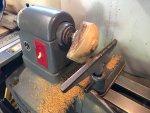Tom Baugues
Member
- Messages
- 2,794
- Location
- Lafayette, Indiana
I made a big mess in my garage tonight. I thought about it all winter long.....I wanted to get back to turning on my big lathe. Tonight was the night. I have no end plans for this piece other than to get used to turning again and sharpen my skills. Maybe the wood will show me what it wants to be. I have forgotten so much.
After cutting some edges off on the bandsaw I got it spinning. After a few very slow and careful cuts I started to feel more comfortable using my bowl gouge. After getting the bottom to rough shape I wanted to turn a tenon so that I could put on my Nova chuck. Here is where my memory left me as I could not remember what tool to use to get a good straight tenon edge. I stopped long enough to sit down and bring up a video on YouTube and saw a guy using a pointed scraper. I have a couple of those so I went back to work and it didn't take long before I had a catch that scared me pretty good. I decided that more education was in order before I got hurt. Not so sure about cutting a tenon with what I had was very smart.
So what should I be using to cut a clean tenon?



After cutting some edges off on the bandsaw I got it spinning. After a few very slow and careful cuts I started to feel more comfortable using my bowl gouge. After getting the bottom to rough shape I wanted to turn a tenon so that I could put on my Nova chuck. Here is where my memory left me as I could not remember what tool to use to get a good straight tenon edge. I stopped long enough to sit down and bring up a video on YouTube and saw a guy using a pointed scraper. I have a couple of those so I went back to work and it didn't take long before I had a catch that scared me pretty good. I decided that more education was in order before I got hurt. Not so sure about cutting a tenon with what I had was very smart.
So what should I be using to cut a clean tenon?





